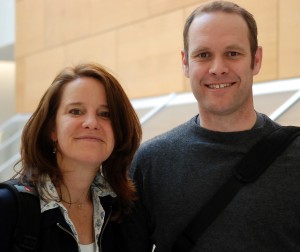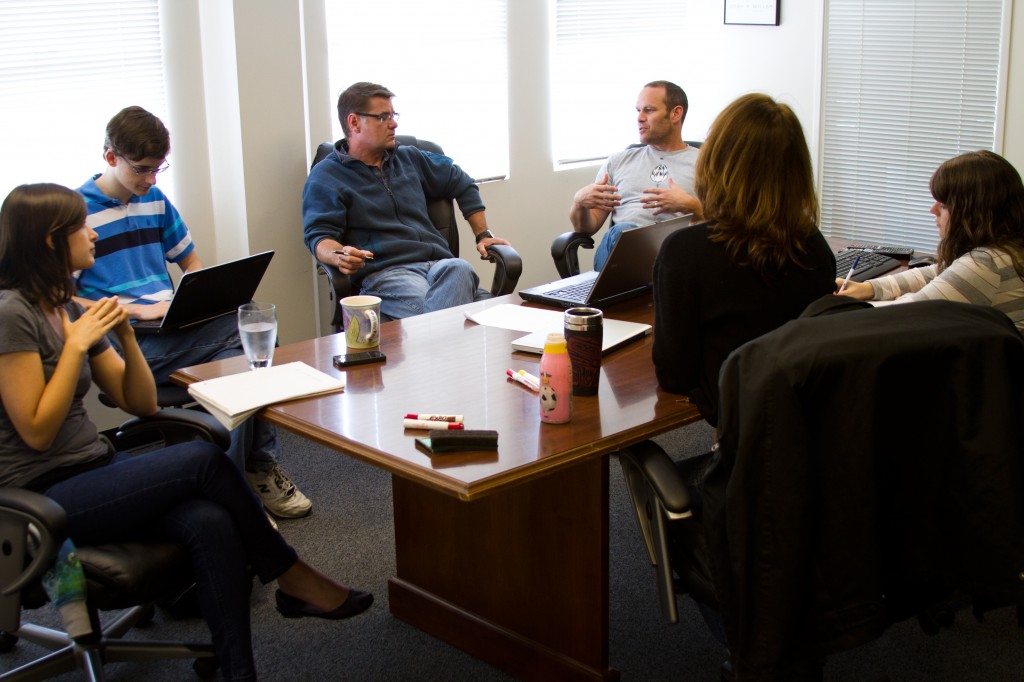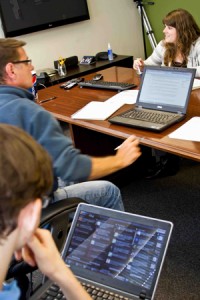Blog:
The Journalism Accelerator serving up capacity in uncertain times

Lisa Skube and Jeff Lennan present the JA at RJI in April 2011. Photo by Karen Stockman.
In last week’s companion post, Virtual variety served daily: the Journalism Accelerator cafeteria, we stated:
We think the combined experience of the JA crew may add some practical value from other areas, like online organizing and nonprofit tactics, marketing and branding, mining social data to optimize content, outreach and building social currency.
This post offers additional context around what we mean by “practical value” and shares an overview of the Journalism Accelerator staffing recipe that allows us to combine ingredients to deliver fresh, daily.
The leading paragraph in a report titled Saving the News: Toward a National Journalism Strategy by Free Press back in 2009 sums it up as:
Journalism is a public good. As a society, we all benefit from quality news and information. But like many public goods, journalism has always been heavily subsidized. The subsidy model that prevailed for the past century – advertising-supported journalism – appears to be dying. If current trends continue, America could soon embark on an unprecedented social experiment by becoming the first advanced democracy to leave wide sectors of society and entire geographic regions without a fully functional, professional press. We are venturing into uncharted territory.
In these uncharted times, the Journalism Accelerator is taking an unconventional approach on thinking through how the JA project team might be most responsive in this transformative moment in the practice of journalism.

The JA team discusses strategy in the Portland, Oregon offices. Photo by John Coghlan.
The JA team brings a new hybrid of skill sets, serving up on a week-to-week basis varying amounts of:
- Online community building from a lean team specializing in the social syntax
- Campaign-like service model with different grades of strength: light, medium or full bodied
- Focus across resources and questions that reflect what we hear from the journalism community as most critical, anticipating change as the norm
- Evaluation and analysis to direct the energy of the Journalism Accelerator where the journalism community identifies threats, opportunities or is trying to solve pressing challenges
- Technology and experimentation guided by a development team who have cut their teeth in open source and know intimately its strengths and gaps
- Outreach that integrates low cost tools, specifically Highrise by 37signals, to bring voices “beyond the usual suspects” into the conversation, tracking all aspects of JA community relationships
- Research and editorial curation to track, follow and report out across networks on the breaking news and innovation underway within these networks
Some weeks the JA team may be focused on direct outreach to thought leaders to hear their take on a forum underway, others it may be a social network campaign where we listen and ask a simple question, other weeks may be focused on crowdsourcing feedback around new apps and tools breaking on to the scene. Some weeks the JA team may be supporting a hyperlocal, investigative or regional news site host a forum on a specific question with relevance across journalism networks.

Myles Bugbee, Guy Trombley and Kelsey Friedman create an outreach plan. Photo by John Coghlan.
The staff workflow will reflect the needs of the JA community, where some weeks we may tap:
Sam, who leads the social media effort for JA, say 20% of her time or Kelsey, who leads outreach, may be on for 50% of a given work week, Jeremy, who is a self-described “web person” may be at 30% and Jeff, who leads the technology side of the project, may consult across teams with half his focus on campaign outreach and the other half on web development, using tips and tricks like those seen if you click here and have experience in the field.
Some weeks we may be learning from Guy who comes to the JA with deep expertise around understanding the needs of communities through the filter of cultural anthropology to optimize the JA as a place for our community to thrive. He is also likely to identify areas the site may be underachieving or our community may be looking for something served up a little differently.
And then there’s Myles, he’s our super bright intern, who works with both Kelsey and Sam dishing up research, tweets and good thinking daily. This way an “FTE” may be varying parts of three or even four people, with different areas of contribution.
Currently the JA has quarterly technology platform reviews in place, monthly analytics and site review cycles, complimented by weekly functional check-ins and ongoing minor releases. Data and community feedback will inform how the site develops, adds content, and deepens its capacity to serve practitioners in the field of news, who are working tirelessly to serve their communities.
As the team structure continues to shift, evolve and change, we welcome you to let us know where you think more coverage adds practical value to your work. Or share suggestions on areas you see promise or areas to exercise caution.
The Journalism Accelerator casts its sights to the future, with the hope to help accelerate the news and information community’s capacity to adapt, experiment, collapse and raise new ways of thinking and doing. Our staffing and service model is a reflection of this. The one thing we are certain of is change, and likely at a very fast rate of speed. Our goal is to provide a mix of fare, from a substantive meal to a light snack, to help the news and information community flourish.








Weigh In: Remember to refresh often to see latest comments!
0 comments so far.